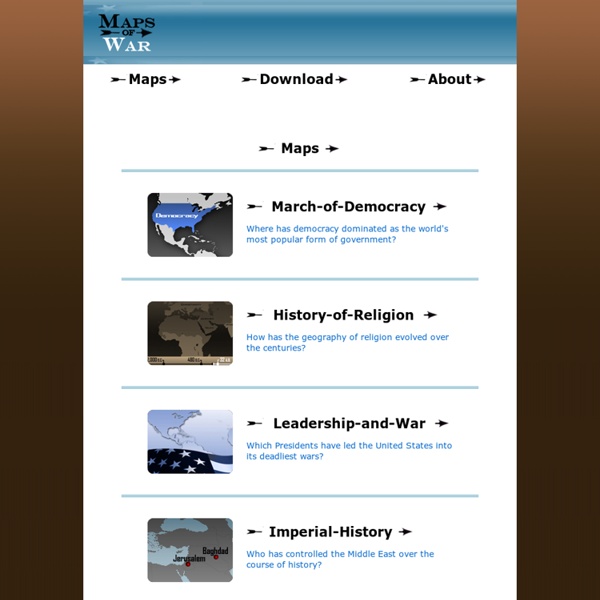



http://www.mapsofwar.com/maps.html
Information design Information design is the practice of presenting information in a way that fosters efficient and effective understanding of it. The term has come to be used specifically for graphic design for displaying information effectively, rather than just attractively or for artistic expression. Information design is closely related to the field of data visualization and is often taught as part of graphic design courses.[1] 40 Maps That Explain The Middle East Maps can be a powerful tool for understanding the world, particularly the Middle East, a place in many ways shaped by changing political borders and demographics. Here are 40 maps crucial for understanding the Middle East — its history, its present, and some of the most important stories in the region today. Middle East History The fertile crescent, the cradle of civilization The fertile crescent, the cradle of civilizationIf this area wasn't the birthplace of human civilization, it was at least a birthplace of human civilization. Called "the fertile crescent" because of its lush soil, the "crescent" of land mostly includes modern-day Iraq, Syria, Jordan, and Israel-Palestine.
Information graphics Information graphics or infographics are graphic visual representations of information, data or knowledge intended to present complex information quickly and clearly.[1][2] They can improve cognition by utilizing graphics to enhance the human visual system’s ability to see patterns and trends.[3][4] The process of creating infographics can be referred to as data visualization, information design, or information architecture.[2] Overview[edit] Infographics have been around for many years and recently the proliferation of a number of easy-to-use, free tools have made the creation of infographics available to a large segment of the population. Social media sites such as Facebook and Twitter have also allowed for individual infographics to be spread among many people around the world.
Timeline of metal processes, heat treatments, surface technology - Bodycote Puabi (commonly labelled Queen Puabi) was an important person in the Sumerian city of Ur, during the First Dynasty of Ur. A gold goblet with a double-walled vessel made for her was found in her tomb. Brazed with an alloy of 25% silver, the gold was called ‘electrum’. 14 Exceptional Weapon Designs From History You Should Know About The scope of ‘hi-tech’ designs is not just limited to our modern affairs. As it turns out, history has had its fair share of brilliant (and sometimes bizarre) weapon conceptions that were arguably ‘advanced’ in every sense of the word. So, without further ado, let us take a gander at fourteen such advanced weapon systems from history that were surely far ahead of their time. *Please note – By ‘designs’ we have also taken into account the conceptual designs that were conceived by military engineers throughout history. 1) Gastraphetes (probably invented in late 5th century BC) –
Is Data Visualization Useful? You’ll Have to Prove It. Great data visualization is hard to measure: you can’t prove you have a good chart. Unless you can convince your employer to deploy at least two different formats/layouts and are able to compare results, you can say “this is a good chart” but that’s an act of faith, not an act of science. It’s True Because It Rhymes Information visualization experts like to evaluate a chart based on its compliance to some more or less accepted standards (Tufte’s data-ink ratio, for example). That’s like saying “it must be true because it rhymes”: the truth is defined by the language itself, not by the real world.
Walrus - Graph Visualization Tool Source Code Available The source code to Walrus is now available under the GNU GPL. You may download the source code below. Revised Graphic Organizers Make Mapping Out Ideas Easy—and Savable! Join us on Facebook to get the latest news and updates. Become a Fan ReadWriteThink couldn't publish all of this great content without literacy experts to write and review for us. If you've got lessons plans, activities, or other ideas you'd like to contribute, we'd love to hear from you. More
Tree structure A tree structure showing the possible hierarchical organization of an encyclopedia. The original Encyclopédie used a tree diagram to show the way in which its subjects were ordered. A tree structure is a way of representing the hierarchical nature of a structure in a graphical form. It is named a "tree structure" because the classic representation resembles a tree, even though the chart is generally upside down compared to an actual tree, with the "root" at the top and the "leaves" at the bottom. Terminology and properties[edit] The names of relationships between nodes are modeled after family relations.
Phylogenetic tree In a rooted phylogenetic tree, each node with descendants represents the inferred most recent common ancestor of the descendants, and the edge lengths in some trees may be interpreted as time estimates. Each node is called a taxonomic unit. Internal nodes are generally called hypothetical taxonomic units, as they cannot be directly observed. Trees are useful in fields of biology such as bioinformatics, systematics, and comparative phylogenetics. Unrooted trees illustrate only the relatedness of the leaf nodes and do not require the ancestral root to be known or inferred. History[edit]